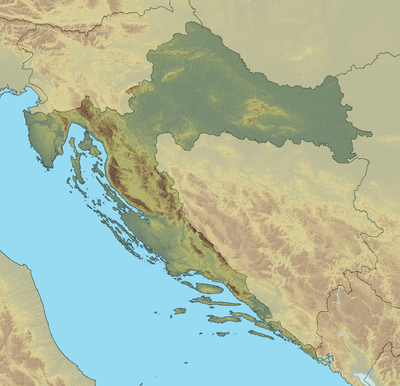1667 Dubrovnik earthquake
The earthquake in Dubrovnik in 1667[2] was one of the two most devastating earthquakes to hit the area of modern Croatia in the last 2,400 years, since records began. The entire city was almost destroyed and around 5,000 people were killed.[1] The city's Rector Simone Ghetaldi was killed and over three quarters of all public buildings were destroyed. At the time, Dubrovnik was the capital of the Republic of Ragusa. The earthquake marked the beginning of the end of the Republic.[3]
 | |
| Local date | 6 April 1667 |
|---|---|
| Epicenter | 42.60°N 18.10°E |
| Areas affected | Dubrovnik, Croatia |
| Max. intensity | X MCS (Disastrous) |
| Casualties | 5,000 dead [1] |
Tectonics
Dubrovnik's region is located in the eastern part of the Adriatic Sea and is a narrow strip of land, dotted by a series of bays, with the Dinaric Alps in the background, and hundreds of islands along the coast.[4] The city of Dubrovnik was built in the most seismically active area in Croatia, which makes earthquakes the strongest in the whole country. It is the only Croatian town that is shown in red on the seismic map, which means that it is exposed to potential hazard of the strongest earthquakes, those of 10 degrees in the Mercalli scale.[5]
Damage
The largest natural disaster in Dubrovnik history happened around 8 in the morning on April 6th, 1667. Survivors of the event witnessed a rumbling sound followed by a tremendous kick that rocked the city.[6] This event is thought to be the biggest one in the history of Dalmatia and practically defines seismic hazard in the coastal area of Croatia.[4] Citizens of the city witnessed huge stones rolling down the hill of Srđ destroying everything in their way. A powerful tsunami devastated the port, flooding everything near the shore. Large cracks appeared in the land, and the city's water sources dried up. The dust created by the destroyed buildings were thick enough to obscure the sky.[6] Strong winds fueled the fire from homes and bakeries, turning it into the blaze that would not be extinguished for almost 20 days.[6]
Aftermath
The Sponza and the Rector's palace were the only buildings that survived the natural disaster. The city was reconstructed in the baroque style that has survived intact to today. Despite the reconstruction, the decline of the Mediterranean as a hub for trade meant that Dubrovnik, like other Mediterranean ports, began a steady decline.[7] Overall, more than 6,000 people were killed, among whom were the Rector and half of the members of the Great council. The effects of the earthquake also resulted in the loss of half of the nobility population.[7]
Thievery
The earthquake had destroyed almost the entire city and buried around 3000 people. Alongside the fire, one more catastrophe came and made terrible damage to the city – robbers.[4] Given that the earthquake killed the Rector and a great part of the government, there was total anarchy. People would cut the ears and jaws from the dead to take their earrings and gold teeth. Everyone was stealing - rich and poor alike.[8]
References
- Eystein S. Husebye (2008). Earthquake Monitoring and Seismic Hazard Mitigation in Balkan Countries. Springer Science & Business Media. p. 86. ISBN 978-1-4020-6815-7.
- Robin Harris (2006). Dubrovnik: A History. Saqi Books. ISBN 978-0-86356-959-3.
- Zdenko Zlatar (1992). Between the Double Eagle and the Crescent: The Republic of Dubrovnik and the Origins of the Eastern Question. East European Monographs. ISBN 978-0-88033-245-3.
- "On the Eve of the Earthquake | Request PDF". ResearchGate. Retrieved 2019-03-25.
- Sović, Ivica; Ivančić, Ines; Markušić, Snježana (2017-08-30). "The 1667 Dubrovnik earthquake – some new insights". Studia geophysica et geodaetica (in Croatian). 61 (3): 587–600. doi:10.1007/s11200-016-1065-4.
- Thomas, Mark. "On this day – the big earthquake of 1667 - The Dubrovnik Times". www.thedubrovniktimes.com. Retrieved 2019-03-25.
- "Dubrovnik earthquake". Dubrovnik Digest. Retrieved 2019-03-25.
- "The history of Dubrovnik". Retrieved 2019-03-25.
Further reading
- Balija, Petrica (April 2015). "Sve se razgrabi ko je bolje mogo: krađe iz ruševina nakon dubrovačkog potresa iz 1667. godine" [Loot and prey while you may: thefts in the aftermath of the 1667 Great Earthquake of Dubrovnik] (PDF). Anali Zavoda za povijesne znanosti Hrvatske akademije znanosti i umjetnosti u Dubrovniku (in Croatian) (53/1): 149–193. Retrieved 7 May 2020.